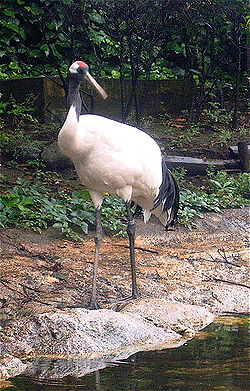Red-crowned crane
| Red-crowned Crane | |
|---|---|

| |
| Scientific classification | |
| Kingdom: | |
| Phylum: | |
| Class: | |
| Order: | |
| Family: | |
| Genus: | |
| Species: | G. japonensis
|
| Binomial name | |
| Grus japonensis | |
The Red-crowned Crane (Grus japonensis), also called the Japanese Crane or Manchurian Crane, is a large crane and is the second rarest crane in the world. In East Asia, it is known as a symbol of luck and fidelity. At 140 cm (55 inches) high, the crane does not make easy prey, for all that it stands out in its natural habitat of marshes and swamps. When it matures, the Red-crowned Crane is snow white with a patch of red skin on its head. This patch of skin becomes bright red when the crane becomes angry or excited. The heaviest crane on record is a male Red-crowned Crane weighing 15 kg (33 lbs.), although large Sarus Cranes are taller.

In the spring and summer, the Red-crowned Crane breeds in Siberia. Normally the crane lays 2 eggs, with only one surviving. Later, in the fall, it migrates in flocks to Korea, Japan, China, Taiwan, and other countries in East Asia to spend the winter. All Red-crowned Cranes migrate, except for a flock that is resident in Hokkaidō.
The crane eats small amphibians, aquatic invertebrates, insects, and plants that grow in marshes and swamps.
The habitat used is marshes, river banks, rice fields, and other wet areas.
Status
The estimated population of the species is only 1,700 - 2,000 individuals in the wild, making it one of the most endangered species of bird. The National Aviary in Pittsburgh, Pennsylvania runs a program where U.S. zoos donate eggs which are flown to Russia and raised in the Khinganski Nature Reserve and released into the wild. This program sent 150 eggs between 1995-2005.
Culture
In Japan, this crane, known as tancho, is said to live 1000 years. A pair of Red-crowned Cranes were used in the design for the D series of the 1000 yen note. In the Ainu language, the Red-crowned Crane is known as sarurun kamui or marsh kamui.
In China, the Red-crowned Crane is often featured in myths and legends. In Taoism, the Red-crowned Crane is a symbol of longevity and immortality. In art and literature, immortals are often depicted riding on cranes. A mortal who attains immortality is similarly carried off by a crane. Reflecting this association, Red-crowned Cranes are called xian he, or fairy crane. The Red-crowned Crane is also a symbol of nobility. Depictions of the crane have been found in Shang Dynasty tombs and Zhou Dynasty ceremonial bronzeware. A common theme in later Chinese art is the reclused scholar who cultivates bamboo and keeps cranes.
Because of its importance in Chinese culture, the Red-crowned Crane was selected by the National Forestry Bureau of the People's Republic of China as its only candidate for the national animal of China. However, recent objections have been raised because of the species' scientific name (Grus japonensis) and common English name ("Japanese Crane"), both of which reference Japan, and not China.
Literature
In Jeff Stone's book, The Five Ancestors, 12-year-old Hok (Cantonese for Crane) spots a Red-crowned Crane.
References
- Template:IUCN2006 Database entry includes a range map, a brief justification of why this species is endangered, and the criteria used
- Craft, Lucille. 1999. "Divided by Politics, United in Flight - Can Japan and Russia Resolve Their Differences Over the Remote Kuril Islands and Protect the Rare Red Crowned Crane?" International Wildlife. 29, no. 3: 22.
